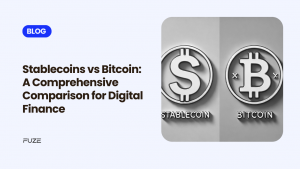Blockchain technology has significantly changed how we manage, record, and verify digital transactions. A key feature of this technology is its transparency, every transaction is logged on a ledger, allowing anyone to monitor on-chain activities in real time. This transparency is not merely a technical achievement; it serves as an essential tool for building trust, confirming payments, and ensuring accountability within a decentralised system.
As blockchain adoption increases, so does its attractiveness to cybercriminals. The surge in hacks, phishing scams, and fraudulent activities aimed at cryptocurrency users and platforms underscores the need for vigilance. Understanding how to track blockchain transactions equips individuals and businesses to identify suspicious activities and enhance their financial security.
This blog provides a comprehensive, step-by-step approach to help you effectively track blockchain transactions, equipping you with the knowledge to remain informed and secure in a rapidly evolving digital environment.
Why Track Blockchain Transactions?
Blockchain transactions are immutable and publicly accessible, offering unique advantages for tracking:
- Transparency: Each transaction is recorded on a public ledger, making it easy to verify.
- Verification: Tracking ensures payments have been processed and received.
- Fraud Prevention: Monitoring transactions can help identify suspicious activities.
- Tax and Audit Purposes: Maintaining a clear record of transactions is crucial for compliance.
Understanding Blockchain Transactions
A blockchain transaction is a transfer of value (e.g., cryptocurrency or token) from one address to another, recorded on a blockchain. Each transaction has the following key components:
- Transaction Hash/ID: A unique identifier for the transaction.
- Sender and Receiver Addresses: The wallet addresses involved in the transaction.
- Block Number: The block containing the transaction.
- Gas Fees: Fees paid to process the transaction.
- Timestamp: The exact time at which the transaction was added to the blockchain.
Tools for Tracking Blockchain Transactions
Tracking transactions requires a blockchain explorer, a tool that allows users to search, verify, and monitor activity on the blockchain. Popular blockchain explorers include:
- Etherscan (for Ethereum-based transactions)
- Blockchain.com Explorer (for Bitcoin and other networks)
- BSCScan (for Binance Smart Chain)
- Solscan (for Solana)
- Polygonscan (for Polygon/Matic)
Step-by-Step Guide to Tracking Blockchain Transactions
Step 1: Locate the Transaction Hash
Every blockchain transaction has a unique hash or ID. If you’re the sender or recipient, you can usually find this in your wallet under the transaction history section. Make sure to copy this hash for tracking purposes.
Step 2: Select a Blockchain Explorer
Choose a blockchain explorer that corresponds to the network used for the transaction. For instance:
For Ethereum, use Etherscan.io
For Bitcoin, use Blockchain.com Explorer
Step 3: Input the Transaction Hash
Navigate to the search bar on the blockchain explorer and paste the transaction hash. Hit Enter or click the search icon to view the details.
Step 4: Analyse the Transaction Details
The explorer will show all relevant details about the transaction, including:
- Status: Indicates whether the transaction is confirmed, pending, or failed.
- Block Number: Identifies the block where the transaction is recorded.
- Sender and Receiver Addresses: Displays the wallets involved in the transaction.
- Amount Transferred: The value of cryptocurrency that was moved.
- Gas Fees: The cost of the transaction paid to miners or validators.
- Timestamp: The exact time when the transaction took place.
Step 5: Monitor Confirmation Status
Most blockchains require a specific number of confirmations to consider a transaction fully processed. The explorer will show how many confirmations there are and whether the transaction has been finalised.
Step 6: Bookmark or Save Transaction Details
If the transaction is important, consider saving the details or bookmarking the page for future reference. Many explorers provide options to export data or create shareable links.
Advanced Features of Blockchain Explorers
- Wallet Activity Monitoring: Enter a wallet address instead of a transaction hash to view its entire transaction history, including all incoming and outgoing transfers.
- Gas Fee Analysis: Some explorers, like Etherscan, provide insights into current gas prices, helping you optimise fees for future transactions.
- Smart Contract Interactions: For transactions involving DeFi platforms or NFTs, explorers show detailed logs of smart contract interactions, including method calls and executed functions.
- Token Tracking: Track the movement of tokens (e.g., ERC-20 or BEP-20) within the transaction to see balances and transfers.
- Real-Time Network Stats: Many explorers offer live metrics, such as transaction throughput, block production times, and network congestion levels.
Common Issues When Tracking Transactions
- Pending Transactions: Transactions can remain pending due to network congestion or low gas fees. Use the explorer to monitor their status and decide whether to resubmit with higher fees.
- Incorrect Blockchain: Using the wrong explorer for a transaction’s network will yield no results. Ensure you are using the correct blockchain explorer.
- Failed Transactions: A transaction may fail due to insufficient gas fees or smart contract errors. The explorer will provide a reason for failure.
- Confusion Between Wallets and Exchanges: When tracking transactions to or from exchanges, remember that the wallet address displayed may belong to the exchange’s internal system, not your personal wallet.
Best Practices for Tracking Blockchain Transactions
- Double-Check Hashes: Ensure the transaction hash is accurate to avoid tracking the wrong transaction.
- Stay Informed About Network Conditions: Monitor network congestion and gas fee trends to better understand delays or failures.
- Leverage Notifications: Some blockchain explorers offer alert systems for specific wallets or transactions, notifying you of updates in real time.
- Use Multi-Network Explorers: Platforms like Blockchain.com or Bitquery.io support multiple blockchains, making it easier to switch between networks.
Conclusion
The transparency of blockchain technology provides exceptional security and traceability, making it a vital resource for verifying transactions, auditing systems, and identifying fraudulent activities. Businesses that accept cryptocurrency payments, users of decentralised finance (DeFi), and even law enforcement agencies depend on transaction tracking to uphold trust and ensure accountability. Beyond financial uses, tracking is also crucial in various fields, such as supply chain management, voting systems, and token-based economies, promoting transparency and integrity.
Understanding how to track blockchain transactions is crucial for anyone involved with cryptocurrencies, whether for personal, business, or regulatory reasons. With the right tools and knowledge, you can effectively verify transactions, ensure compliance, and maintain the transparency necessary for secure operations within the blockchain ecosystem.
By following the steps and best practices outlined in this guide, you will enhance your understanding of blockchain operations and utilise its transparency to remain informed, secure, and empowered in the decentralised landscape.
Disclaimer: Virtual assets carry significant risks, including high volatility and potential loss of your entire investment. They are not backed by governmental protections, and recourse may be limited in case of loss. Always assess your risk tolerance, fully understand the risks, and seek independent financial advice if needed before investing.
Frequently Asked Questions
- What does “pending” mean in transaction tracking?
A “pending” status indicates that the transaction has been broadcast to the network but has not yet been confirmed by validators or miners. This can occur due to network congestion or low gas fees. - What should I do if a transaction is taking too long to confirm?
If a transaction is delayed, check the network’s current gas fees and congestion levels using a blockchain explorer. You may need to resubmit the transaction with higher fees if the option is available. - Can I track transactions across multiple blockchains?
Yes, but you’ll need to use a blockchain explorer specific to each blockchain. Some platforms, like Blockchain.com and Bitquery, support multi-chain tracking for added convenience. - Is tracking blockchain transactions secure?
Yes, tracking is secure because you are accessing publicly available data stored on the blockchain. It does not require private keys or personal credentials. - Can blockchain tracking help detect fraud?
Yes, transaction tracking is a powerful tool for identifying unusual patterns, verifying the authenticity of payments, and monitoring suspicious wallet activities. It is widely used by individuals, businesses, and law enforcement to combat fraud.







